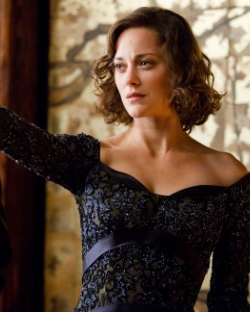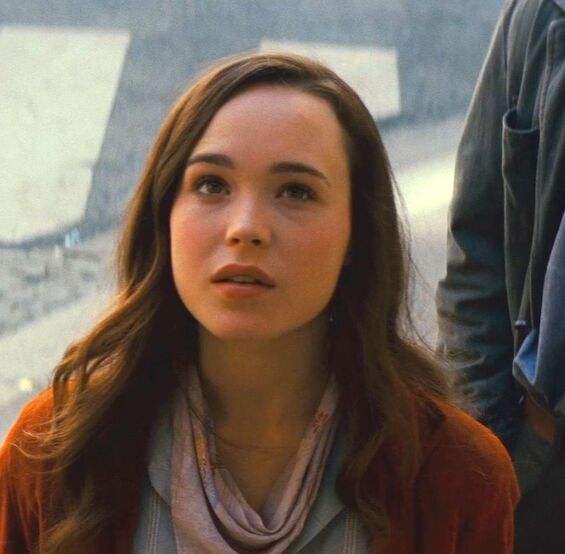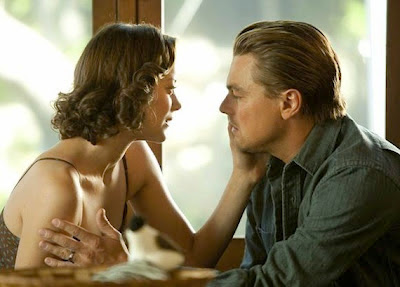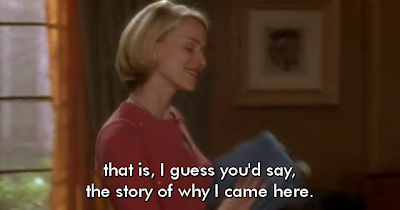 |
| י-ה-ו-ה |
The Inception sequence: Yod (Dom) Heh (Mal) Vau (Arthur) Heh (Ariadne).
ACCORDING to the ancient oral tradition of the Hebrews, or Kabbalah, a sacred word exists, which gives to the mortal who can discover the correct way of pronouncing it, the key to all the sciences, divine and human. This word, which the Israelites never uttered, and which the High Priest pronounced once a year, amidst the shouts of the laity, is found at the head of every initiative ritual, it radiates from the centre of the flaming triangle at the 33rd degree of the Freemasonry of Scotland, it is displayed above the gateways of our old cathedrals, is formed of four Hebrew letters, and reads thus, Yod-he-vau-he, יהוה. [...]
THE YOD.
The Yod, shaped like a comma or a dot, represents the principle or origin of all things.
The other letters of the Hebrew alphabet are all produced by different combinations of the letter Yod. 1 The synthetic study of nature had led the ancients to conclude that one law only existed, and ruled all natural productions. This law, the basis of analogy, placed the Unity-principle at the origin of all things, and regarded them as the reflections at various degrees of this Unity-principle. Thus the Yod, which alone forms all the other letters, and therefore all the words and all the phrases of the alphabet, was justly used as the image and representation of this Unity-principle, of which the profane had no knowledge.
Thus the law which presided over the creation of the Hebrew language is the same law that presided over the creation of the Universe, and to know the one is to know the other, unreservedly. [...]
The Kabbalah, therefore, places at the origin of all things the absolute assertion of the being by itself of the Ego-Unity, which is represented by the yod symbolically, and by the number 10. This number 10, representing the All-principle 1, with the Zero-nothing 0, well supplies the requisite conditions.
THE HE.
But the Ego cannot be realized except through its opposition to the Non-Ego. The assertion of the Ego is scarcely established, when we must instantly realize a reaction of the Ego, Absolute, upon itself, from which the conception of its existence will be drawn, by a kind of division of the Unity. This is the origin of duality, of opposition, of the Binary, the image of femininity, even as the Unity is the image of the masculine. Ten, divided by itself, in opposition to itself, then equals 10/2 = 5, five, the exact number of the letter He, the second letter of the great sacred name.
The He therefore represents the passive in relation to the Yod, which symbolizes the active; the Non-Ego in relation to the Ego, the woman relatively to the man; the substance relatively to the essence; life in its relation to the soul, &c., &c.
THE VAU.
But the opposition of the Ego and the Non-Ego immediately gives rise to another factor; this is the Affinity existing between this Ego and this Non-Ego.
Now the Vau, the sixth letter of the Hebrew alphabet, produced by 10 (yod) + 5 (he) = 15 = 6 (or 1 + 5), signifies link or analogy. It is the link which, uniting antagonisms in the whole of nature, constitutes the third word of this mysterious Trinity.
Ego--Non-Ego.
Affinity of the Ego with the Non-Ego.
THE 2nd HE.
Nothing can exist beyond this Trinity, considered as a law.
The Trinity is the synthetic and absolute formula to which all the sciences converge; and this formula, forgotten with regard to its scientific value, has been transmitted to us integrally, by all the religious of the world, the unconscious depositaries of the SCIENCE WISDOM of primitive civilizations.
Thus the great sacred name is formed of three letters only. The fourth term of the name is formed by the repetition of the second letter, the He.
This repetition indicates the passage of the Trinitarian law into a new application; that is, to speak correctly, a transition from the metaphysical to the physical world, or generally, of any world whatever to the world that immediately follows it.
The knowledge of the property of the second He is the key to the whole divine name, in every application of which it is susceptible. [...] The second He marks the passage from one world to another. The Transition. [The Kick?]
This second He represents the complete Being, comprising in one Absolute Unity the three letters which compose it: Ego, Non-Ego, Affinity. (Papus, The Tarot of the Bohemians)
The Father (King, but Knight in the Thoth deck) encounters the barren Mother (Queen) . . .
. . . and incarnates the Son (Prince) who weds the Daughter (Page), healing the Old King and setting her on the throne of the old Mother (Ariadne killing Mal).
Starting from a fixed and immovable principle, the constitution of the sacred tetragrammaton, Yod-he-vau-he, the Tarot develops the most divers combinations, without one departure from its basis. [...] when we consider the four colours of the Tarot, new deductions will be called forth. We must remember that these four colours are: the Sceptre, the Cup, the Sword, and the Money or Pentacles.
The Sceptre represents the Male or the Active.
The Cup is the image of the Passive or Feminine.
The Sword represents the union of the two by its crucial form.
Lastly, the Pentacles represent the second He.
The authors who have philosophically studied the Tarot are all unanimous in asserting the analogy that exists between the tetragrammaton and the four colours. (Papus)
 |
| Stairway to heaven? Or Isis incognito? |
 |
| Inception (21: The Universe) |
After Senator John McCain named Alaska Governor Sarah Palin as his running mate on the Republican presidential ticket, it was revealed in September 2008 that Gov. Palin's daughter, Bristol, age 17, was pregnant with the child of another teenager. News reports and editorials termed Bristol Palin's pregnancy as the latest episode in the debate over teen pregnancy of which Juno was a part,[85][86] while conservative commentators made comparisons between Bristol Palin's pregnancy and the film.[87][88] Noted New Republic literary editor Leon Wieseltier, "The Republicans wanted a new conversation, and they got one. Juno in Juneau!"[87] Fox News' Roger Friedman wondered, "Juno at once violated and vindicated conservative values. The question is, will the public rally ‘round Bristol Palin the way it did Juno? Or will it reject her for getting in this situation in the first place?" ("Juno (film)")
 |
| Anima Mundi |
 |
| Juno: the Zeitgeist made flesh? |
In fiction, a MacGuffin (sometimes McGuffin or maguffin) is a plot device in the form of some goal, desired object, or other motivator that the protagonist (and sometimes the antagonist) is willing to do and sacrifice almost anything to pursue, often with little or no narrative explanation as to why it is considered so desirable.
The equilibrium of all things is hereby symbolized. It is the final adjustment in the formula of Tetragrammaton, when the daughter, redeemed by her marriage with the Son, is thereby set up on the throne of the mother; thus, finally, she “awakens the Eld of the All-Father.” . . .Nature (holy wood), we are told, is the garment of God. Lolita (Lila) is Subject and Object, perceiver and perceived; as Isis veiling herself with the multifaceted forms of visible existence, she clothes herself in popular culture.
The figure is that of a young and slender woman poised exactly upon toetip. She is crowned with the ostrich plumes of Maat, the Egyptian goddess of Justice, and on her forehead is the Uraeus serpent, Lord of Life and Death. She is masked, and her expression shows her secret intimate satisfaction in her domination of every element of dis-equilibrium in the Universe. This condition is symbolized by the Magic Sword which she holds in both hands, and the balances or spheres in which she weighs the Universe, Alpha the First balanced exactly against Omega the Last. . . .
This woman-goddess is Harlequin; she is the partner and fulfillment of The Fool. She is the ultimate illusion which is manifestation; she is the dance, many-coloured, many-wiled, of Life itself. Constantly whirling, all possibilities are enjoyed, under the phantom show of Space and Time: all things are real, the soul is the surface, precisely because they are instantly compensated by this Adjustment. All things are harmony and beauty; all things are Truth: because they cancel out.
She is the goddess Maat; she bears upon her nemyss the ostrich feathers of the Twofold Truth. . . . She represents Manifestation, which may always be cancelled out by equilibration of opposites.
She is wrapped in a cloak of mystery, the more mysterious because diaphanous; she is the sphinx without a secret, because she is purely a matter of calculation. (Aleister Crowley)
The basic recurring theme in Hindu mythology is the creation of the world by the self-sacrifice of God - ‘sacrifice’ in the original sense of ‘making sacred’ - whereby God becomes the world which, in the end, becomes again God. This creative activity of the Divine is called lila, the play of God, and the world is seen as the stage of the divine play. Like most of Hindu mythology, the myth of lila has a strong magical flavour. Brahman is the great magician who transforms himself into the world and then performs this feat with his ‘magic creative power’, which is the original meaning of maya in the Rig Veda. The word maya - one of the most important terms in Indian philosophy - has changed its meaning over the centuries. From the might, or power, of the divine actor and magician, it came to signify the psychological state of anybody under the spell of the magic play. As long as we confuse the myriad forms of the divine lila with reality, without perceiving the unity of Brahman underlying all these forms, we are under the spell of maya. (Fritjof Capra, The Tao of Physics)
Lolita lives in a fantasy world of film where she is a starlet. Her actions follow those of the movie stars of her era. Appel goes to great lengths to examine the extent to which American pop culture informed the creation of the characters in Lolita. Lolita is consumed by it. Humbert, an immigrant, is unfamiliar with it. “The two dimensions of reel life [...] are most pervasive reality in Lolita’s America. Humbert’s unfailingly dim view of Hollywood is consistent with his characterization as a displaced European intellectual.” (7) Appel suggests that there is both a cultural and an æsthetic-based divide between Humbert’s European professor and Lolita’s Hollywood-obsessed wannabe starlet. [...]
His Lolita is defined by the popular culture of her era. Her room is covered in movie posters and she reads movie magazines on the road. Indeed, the first image the viewer is presented with after Humbert and Lolita’s first love scene is of Lolita reading Movie Story in their car. [...]
Lolita’s character is in many ways defined by her consumption of popular culture in Lyne’s film. After all, the subjective æsthetic is centred on Humbert and he would often see Lo listening to music. In the novel, he is often forced to take her to movies. It is unclear, however, whether Humbert shares the reader/viewer’s acknowledgment of how Lolita patterns her life after the characters in the films she sees. If Humbert does not recognize these touchstones, then the viewer is subtly given an objective stance contrary to the subjective æsthetic elsewhere in the film. Humbert’s untrustworthy nature is further underlined by the fact that he fails to understand the motivations of the woman he is supposed to love. In either case, it is clear that Lolita is searching for an identity of her own through, ironically, mass culture. Lolita’s character is largely based on her consumption of popular culture. Music and films, in particular, help to create her psyche. Since popular culture can denote the expressive of subjectivity through widely recognized codes, this may suggest that Lolita’s character may be nothing more than a series of such codes. (Michael Da Silva)
Lil the Dancer is a fictional character in the David Lynch movie Twin Peaks: Fire Walk with Me. The dancer's movements are code . . . ("Lil the Dancer")

DESMOND: Gordon said you were good. The tailored dress is our code for drugs. Did you notice what was pinned to it?
STANLEY: A blue rose.
DESMOND: Very good, but I can't tell you about that.
Stanley rides along quietly for a while.
MISSING DIALOGUE:
STANLEY: What did Gordon's tie mean?
DESMOND: What? That's just Gordon's bad taste.
STANLEY: Why couldn't he have just told you all these things?
DESMOND: He talks loud. And he loves his code.
STANLEY: I see. He DOES talk loud.
 |
| The director: the Hierophant? |
COBB: No, no, don't show me specifics. Only the dreamer should know the layout.
ARIADE: Why is that so important?
COBB: In case one of us brings in our projections. We don't want them knowing the details of the maze.
ARIADNE: Which means, in case you bring Mal in. You can't keep her out, can you? You can't build because if you know the maze, she knows it. She'd sabotage the whole operation. Cobb, do the others know?
COBB: No. They don't.
ARIADNE: You've got to warn them if this is getting worse.
COBB: No one said it's getting worse. I need to get home. That's all I care about right now.
(All the world's a stage: For every starlet, it seems, there lurks a director behind the scenes . . .)
"How long until Sylvia's out of the basement?"
 |
| The Cut-Up Technique (Tikkun Olam) |
(Jareth dismembering Sarah's pages)
 |
| Frank, Franco, or Otto Frank? |
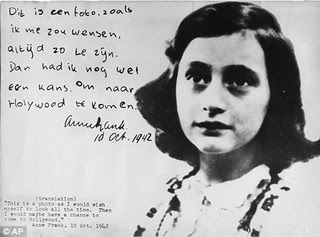 |
| The Shekinah in exile? |
"This is a photo as I would wish myself to look all the time. Then I would maybe have a chance to come to Hollywood." (Anne Frank, '42)
There was separation between the King and Matrona in respect of the outer world and so came about a separation in the Divine Name, for the final He was detached and came down on earth, the source of graces coming with her. Though it is forbidden to separate the Heavenly Bride and Bridegroom, even in thought, it is this which has come to pass by reason of the sufferings of Israel, with whom Shekinah was destined as we have seen to endure even from the beginning. When Israel is in exile the Shekinah is also in exile. It is for this reason that the Holy One will remember Israel; meaning that He remembers His covenant, "which is Shekinah." The symbolical position is summed up in the statement that the second He was obscured and fell, becoming a symbol of penitence. (Arthur Waite)
(The It girl, or Das Es?)
"id: 1924, in Joan Riviere's translation of Freud's 'Das Ich und das Es' (1923), from L. id 'it' (translation of Ger. es 'it' in Freud's title), used in psychoanalytical theory to denote the unconscious . . ."
(Ellen Page is "It" . . .)
The second He, upon which we are intentionally dwelling at some length, may be compared to a grain of wheat relatively to the ear. The ear, the Trinity, manifest or yod-he-vau, exerts all its activity in the production of the grain of wheat, or second He. But this grain of wheat is only the transition between the ear which gave it birth, and the ear to which it will itself give birth in the following generation. It is the transition between one generation and another which it contains in germ; this is why the second He is a Yod in germ. [...] This sequence of numbers 1, 2, 3, and 4, representing the active, the passive, the neuter, and a second active principle, corresponds in all points with the series of the letters of the sacred name [...] We can prove the truth of these analogies by the identity of the action of the number 4, which becomes a unity (4 = 10 = 1), and of the second He, which represents the Yod of the following sequence. (Papus)
 |
| Zion in Oz |
 |
| King and Matrona: The Scarecrow and Dorothy? |
(The Daughter fell in with the pigs)
(The horrors of the crucifixion: "Eloi Eloi lama sabachthani?")
("August 25th, 1939 is a Friday. It is the 237th day of the year . . .")
Film historian Geoffrey Cocks has extended Blakemore's idea that the film has a subtext about Native Americans to arguing that the film indirectly reflects Stanley Kubrick's concerns about the Holocaust. (Both Cocks' book and Michael Herr's memoir of Kubrick discuss how he wanted his entire life to make a film dealing directly with the Holocaust, but could never quite get the handle on it that satisfied him.) Cocks is a cultural historian best known for describing the impact of the Holocaust on subsequent Western culture. Cocks, writing in his book The Wolf at the Door: Stanley Kubrick, History and the Holocaust, proposed a controversial theory that all of Kubrick's work is informed by the Holocaust; there is, he says, a strong (though hidden) holocaust subtext in The Shining. ("The Shining (film)")
(One week later . . .)
"Dorothy makes her way through countless trials and tribulations on her determined quest to find her true home. During this perilous journey, the Wicked Witch of the West embodies the worst of Nazi tyranny—Hitler’s personal messenger sent to torment the innocent Jewess trapped in a strange land whose dangers she could not comprehend."
 |
| Anne Frank Goes to Hollywood |
Anne did not only keep a diary. She also wrote short stories that she invented herself. Two famous movie stars from that period, Priscilla en Rosemary Lane, appear in in her short story Delusions of Stardom. The protagonist in the story is called Anne Franklin. She lives with her parents in Amsterdam and she is a big fan of the Lane sisters. Anne Franklin writes a letter to Priscilla Lane and gets a reply! They write many letters to each other and Priscilla invites her to pay a visit in Hollywood. Anne goes to Hollywood and Priscilla shows her California. Anne Franklin is also allowed to attend the filming of Priscilla’s new film. Priscilla tells Anne that she should ask if there is any work for her. Anne does this and gets the opportunity to be part of tennis ads. She has to go to a studio for an entire week so that they can take photos of her. (Anne Frank Guide)
 |
| Dorothy: lost in Hollywood? |
(Illustration: The Fresh Prince [Vau] picks up the Princess [2nd Heh], she's a '12-year-old runaway.' The parents [Yod and Heh] 'just don't understand.')
"Did you just come from church?"

(Lindsay is "It")

